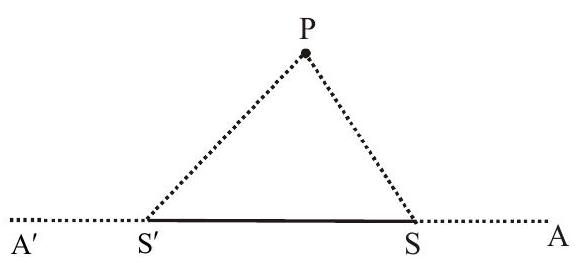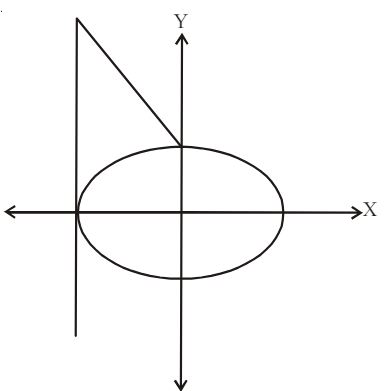Ellipse (Lecture-02)
1. The points, where the normal to the ellipse
(a)
(b)
(c)
(d)
Show Answer
Solution:
Let
Equation of normal at
In ellipse
Slope of normal is
put in(1) we get
options (a) and (b) are correct
2. If the tangent to the ellipse
(a)
(b)
(c) 0
(d)
Show Answer
Solution:
Given ellipse is
Equation of tangent at
i.e.
(1) is a normal to the circle
Hence,
3. The slope of a common tangent to the ellipse
(a)
(b)
(c)
(d)
Show Answer
Solution:
Equation of any tangent to the given ellipse is
If it touches the circle
Squaring
correct option is (b)
4.
(a)
(b)
(c)
(d) None of these
Show Answer
Solution:
Maximum area corresponds to
correct option is (a)
5. An ellipse is described by using an endless string which is passed over two pins. If the axes are
(a)
(b)
(c)
(d) None of these
Show Answer
Solution:
Given

Distance between foci
length of string
Correct option is ’d’
6. If the chords of contact of tangents from two points
(a)
(b)
(c)
(d)
Show Answer
Solution:
The equations of the chords of contact of tangents drawn from
It is given that (1) and (2) are at right angles

correct option is c
7. On the ellipse
(a)
(b)
(c)
(d)
Show Answer
Solution:
We have equation of ellipse as
and tangent line is parallel to
The required points are
i.e.
correct options are (b) & (d)
PRACTICE EXERCISE SECTION - A
1. The equation of the circle drawn with the two foci of
(a)
(b)
(c)
(d)
Show Answer
Answer: d2. The radius of the circle passing through the foci of the ellips
(a) 4
(b) 3
(c)
(d)
Show Answer
Answer: a3.
(a)
(b)
(c)
(d)
4. The semi latus rectum of an ellipse is
(a) The AM of the segments of its focal chord.
(b) The GM of the segments of its focal chord
(c) The HM of the segments of its focal chord
(d) None of these
5. The following equation represents an ellipse
6. Let
7. In an ellipse, if the lines joining a focus to the extremities of the minor axis make an equilateral triangle with the minor axis, the eccentricity of the ellipse is
(a)
(b)
(c)
(d)
8. Column Matching :
For the ellipse
| Column I | Column II | ||
|---|---|---|---|
| 1 | a | a directrix | |
| 2 | b | a latus rectum | |
| 3 | minor axis | ||
| 4 | d | major axis |
9. The equation of the ellipse whose focus is (
(a)
(b)
(c)
(d) None of these
10. The centre of the ellipse
Show Answer
Answer: 2, 3PRACTICE EXERCISE SECTION - B
1. The sum of the squares of the reciprocals of two perpendicular diameter of an ellipse is
(a)
(b)
(c)
(d) None of these
Show Answer
Answer: a2. Prove that any point on the ellipse whose foci are
Show Answer
Answer:3. Let
(a)
(b)
(c)
(d)
Show Answer
Answer: d4.
(a) ab
(b)
(c)
(d) None of these
Show Answer
Answer: a5. A man running round a race course notes that the sum of the distances of two flag-posts from him is always
(a)
(b)
(c)
(d)
Show Answer
Answer: a6. If the line
(a) 1
(b) 2
(c) 4
(d)
Show Answer
Answer: b7. If PSQ is a focal chord if the ellipse
(a) 1
(b) 2
(c) 3
(d) 4
Show Answer
Answer: b8. If equation of the ellipse is
(a) equation of director circle is
(b) director circle will pass through
(c) equation of auxillary circle is
(d) None of these
Show Answer
Answer: c9. The foci of ellipse
(a)
(b)
(c)
(d)
Show Answer
Answer: bPRACTICE EXERCISE SECTION - C
1. If
(a) 8
(b) 6
(c) 10
(d) 12
Show Answer
Answer: c2. The length of the major axis of the ellipse
(a) 10
(b)
(c)
(d) 4
Show Answer
Answer: b3. Angle subtended by common tangents of two ellipses
(a)
(b)
(c)
(d)
Show Answer
Answer: b4. The distance of a point on the ellipse
(a)
(b)
(c)
(d)
Show Answer
Answer: a, b5. If the chord through the points whose eccentric angles are
(a)
(b) -9
(c)
(d) 9
Show Answer
Answer: c, d6. In an ellipse the distance between its foci is 6 and its minor axis is 8, the eccentricity of the ellipse is
(a)
(b)
(c)
(d)
Show Answer
Answer: b7. The number of values of
(a) 0
(b) 2
(c) 1
(d)
Show Answer
Answer: b8. The line
(a)
(b)
(c)
(d)
Show Answer
Answer: b9. Tangents are drawn to the ellipse
(a) 2
(b) 3
(c) 4
(d) 0
Show Answer
Answer: b10. Tangents are drawn to the ellipse
(a) 27
(b)
(c)
(d)
Show Answer
Answer: a11. An ellipse passes through the point (
(a)
(b)
(c)
(d) None of these
Show Answer
Answer: b, c12. The tangent at the point
Show Answer
Answer:13. Find the equations of tangents to the ellipse
Show Answer
Answer:14. Linked Comprehension Type.
For all real
(i) The eccentricity of the ellipse is
(a)
(b)
(c)
(d)
(ii) The foci of ellipse are
(a)
(b)
(c)
(d) None of these
(iii) The locus of point of intersection of perpendicular tangents is
(a)
(b)
(c)
(d) None of these
Show Answer
Answer: (i) a (ii) d (iii) a15.
(i) If
(a)
(b)
(c)
(d) None of these
(ii) If
(a)
(b)
(c)
(d) None of these
(iii) If
(a)
(b)
(c)
(d) None of these
Show Answer
Answer: (i) a (ii) d (iii) c16. The ellipse
(i) The eccentricity of the ellipse is
(a)
(b)
(c)
(d) None of these
(ii) Equation of auxilliary circle of ellipse is
(a)
(b)
(c)
(d) None of these
(iii) Length of latus rectum of the ellipse is
(a) 2 units
(b) lunit
(c) 3units
(d) 2.5 units
Show Answer
Answer: (i) a (ii) c (iii) b17. The equation of the straight lines joining the foci of the ellipse
(a) 15
(b) 30
(c) 20
(d) 18
Show Answer
Answer: bPRACTICE EXERCISE SECTION - D
1. In the normal at the end of latus rectum of the ellipse
(a)
(b)
(c)
(d)
Show Answer
Answer: b2. If the normals to
(a)
(b)
(c)
(d) None of these
Show Answer
Answer: b3. If the normal at an end of a latus rectum of an ellipse passes through one extremity of the minor axis, then the eccentricity of the ellipse is given by
(a)
(b)
(c)
(d) None of these
Show Answer
Answer: a4. The number of normals that can be drown from a point to a given ellipse is
(a) 2
(b) 3
(c) 4
(d) 1
Show Answer
Answer: c5. If the normal at any point
(a)
(b)
(c)
(d)
Show Answer
Answer: c6. If normal to ellipse
(a)
(b)
(c)
(d) None of these
Show Answer
Answer: c7. If normal at any point
(a)
(b)
(c)
(d) None of these
Show Answer
Answer: c8. If the tangent drown at point
(a)
(b)
(c)
(d) None of these
Show Answer
Answer: a9. The normals at four points on the ellipse
(a)
(b)
(c)
(d)
Show Answer
Answer: d10. The equation of the normal at the point
(a)
(b)
(c)
(d)
Show Answer
Answer: b11. Number of distinct normal lines that can be drawn to the ellipse
(a) one
(b) two
(c) three
(d) four
Show Answer
Answer: c12. Any ordinate MP of the ellipse
(a)
(b)
(c)
(d)
Show Answer
Answer: c13. If the normals at
(a)
(b)
(c)
(d)










